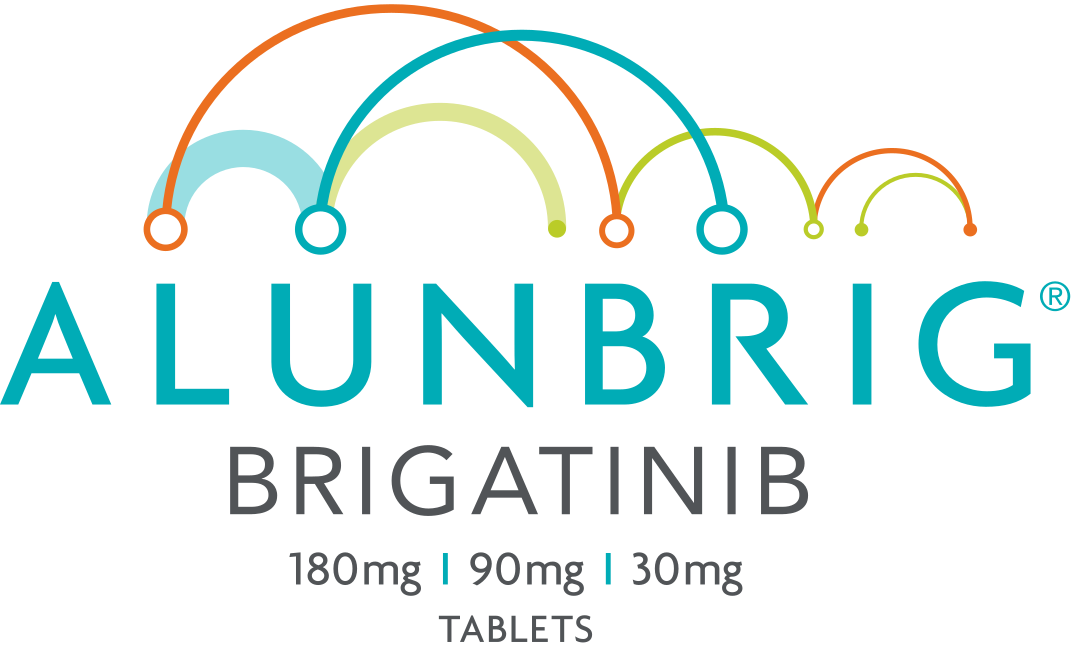Learn about a treatment option for adult patients with ALK+ metastatic non-small cell lung cancer


INDICATION
ALUNBRIG® (brigatinib) is indicated for the treatment of adult patients with anaplastic lymphoma kinase (ALK)-positive metastatic nonsmall cell lung cancer (NSCLC) as detected by an FDA-approved test.
Please see full Prescribing Information.
Interstitial Lung Disease (ILD)/Pneumonitis: Severe, life-threatening, and fatal pulmonary adverse reactions consistent with interstitial lung disease (ILD)/pneumonitis have occurred with ALUNBRIG. In the ALUNBRIG arm of trial ALTA 1L (180 mg once daily), ILD/pneumonitis occurred in 5.1% of patients receiving ALUNBRIG. ILD/pneumonitis occurred within 8 days of initiation of ALUNBRIG in 2.9% of patients, with Grade 3 to 4 reactions occurring in 2.2% of patients. In Trial ALTA, ILD/pneumonitis occurred in 3.7% of patients in the 90 mg group (90 mg once daily) and 9.1% of patients in the 90→180 mg group (180 mg once daily with 7-day lead-in at 90 mg once daily). Adverse reactions consistent with possible ILD/pneumonitis occurred within 9 days of initiation of ALUNBRIG (median onset was 2 days) in 6.4% of patients, with Grade 3 to 4 reactions occurring in 2.7%. Monitor for new or worsening respiratory symptoms (e.g., dyspnea, cough, etc.), particularly during the first week of initiating ALUNBRIG. Withhold ALUNBRIG in any patient with new or worsening respiratory symptoms, and promptly evaluate for ILD/pneumonitis or other causes of respiratory symptoms (e.g., pulmonary embolism, tumor progression, and infectious pneumonia). For Grade 1 or 2 ILD/pneumonitis, either resume ALUNBRIG with dose reduction after recovery to baseline or permanently discontinue ALUNBRIG. Permanently discontinue ALUNBRIG for Grade 3 or 4 ILD/pneumonitis or recurrence of Grade 1 or 2 ILD/pneumonitis.
Hypertension: In the ALUNBRIG arm of trial ALTA 1L (180 mg once daily), hypertension was reported in 32% of patients receiving ALUNBRIG; Grade 3 hypertension occurred in 13% of patients. In ALTA, hypertension was reported in 11% of patients in the 90 mg group who received ALUNBRIG and 21% of patients in the 90→180 mg group. Grade 3 hypertension occurred in 5.9% of patients overall. Control blood pressure prior to treatment with ALUNBRIG. Monitor blood pressure after 2 weeks and at least monthly thereafter during treatment with ALUNBRIG. Withhold ALUNBRIG for Grade 3 hypertension despite optimal antihypertensive therapy. Upon resolution or improvement to Grade 1, resume ALUNBRIG at the same dose. Consider permanent discontinuation of treatment with ALUNBRIG for Grade 4 hypertension or recurrence of Grade 3 hypertension. Use caution when administering ALUNBRIG in combination with antihypertensive agents that cause bradycardia.
Bradycardia: In the ALUNBRIG arm of trial ALTA 1L (180 mg once daily), heart rates less than 50 beats per minute (bpm) occurred in 8.1% of patients receiving ALUNBRIG. Grade 3 bradycardia occurred in 1 patient (0.7%). In ALTA, heart rates less than 50 beats per minute (bpm) occurred in 5.7% of patients in the 90 mg group and 7.6% of patients in the 90→180 mg group. Grade 2 bradycardia occurred in 1 (0.9%) patient in the 90 mg group. Monitor heart rate and blood pressure during treatment with ALUNBRIG. Monitor patients more frequently if concomitant use of drug known to cause bradycardia cannot be avoided. For symptomatic bradycardia, withhold ALUNBRIG and review concomitant medications for those known to cause bradycardia. If a concomitant medication known to cause bradycardia is identified and discontinued or dose adjusted, resume ALUNBRIG at the same dose following resolution of symptomatic bradycardia; otherwise, reduce the dose of ALUNBRIG following resolution of symptomatic bradycardia. Discontinue ALUNBRIG for life-threatening bradycardia if no contributing concomitant medication is identified.
Visual Disturbance: In the ALUNBRIG arm of trial ALTA 1L (180 mg once daily), Grade 1 or 2 adverse reactions leading to visual disturbance including blurred vision, photophobia, photopsia, and reduced visual acuity were reported in 7.4% of patients receiving ALUNBRIG. In ALTA, adverse reactions leading to visual disturbance including blurred vision, diplopia, and reduced visual acuity, were reported in 7.3% of patients treated with ALUNBRIG in the 90 mg group and 10% of patients in the 90→180 mg group. Grade 3 macular edema and cataract occurred in one patient each in the 90→180 mg group. Advise patients to report any visual symptoms. Withhold ALUNBRIG and obtain an ophthalmologic evaluation in patients with new or worsening visual symptoms of Grade 2 or greater severity. Upon recovery of Grade 2 or Grade 3 visual disturbances to Grade 1 severity or baseline, resume ALUNBRIG at a reduced dose. Permanently discontinue treatment with ALUNBRIG for Grade 4 visual disturbances.
Creatine Phosphokinase (CPK) Elevation: In the ALUNBRIG arm of trial ALTA 1L (180 mg once daily), creatine phosphokinase (CPK) elevation occurred in 81% of patients who received ALUNBRIG. The incidence of Grade 3 or 4 CPK elevation was 24%. Dose reduction for CPK elevation occurred in 15% of patients. In ALTA, CPK elevation occurred in 27% of patients receiving ALUNBRIG in the 90 mg group and 48% of patients in the 90 mg→180 mg group. The incidence of Grade 3-4 CPK elevation was 2.8% in the 90 mg group and 12% in the 90→180 mg group. Dose reduction for CPK elevation occurred in 1.8% of patients in the 90 mg group and 4.5% in the 90→180 mg group. Advise patients to report any unexplained muscle pain, tenderness, or weakness. Monitor CPK levels during ALUNBRIG treatment. Withhold ALUNBRIG for Grade 3 or 4 CPK elevation with Grade 2 or higher muscle pain or weakness. Upon resolution or recovery to Grade 1 CPK elevation or baseline, resume ALUNBRIG at the same dose or at a reduced dose.
Pancreatic Enzyme Elevation: In the ALUNBRIG arm of trial ALTA 1L (180 mg once daily), amylase elevation occurred in 52% of patients and Grade 3 or 4 amylase elevation occurred in 6.8% of patients. Lipase elevations occurred in 59% of patients and Grade 3 or 4 lipase elevation occurred in 17% of patients. In ALTA, amylase elevation occurred in 27% of patients in the 90 mg group and 39% of patients in the 90→180 mg group. Lipase elevations occurred in 21% of patients in the 90 mg group and 45% of patients in the 90→180 mg group. Grade 3 or 4 amylase elevation occurred in 3.7% of patients in the 90 mg group and 2.7% of patients in the 90→180 mg group. Grade 3 or 4 lipase elevation occurred in 4.6% of patients in the 90 mg group and 5.5% of patients in the 90→180 mg group. Monitor lipase and amylase during treatment with ALUNBRIG. Withhold ALUNBRIG for Grade 3 or 4 pancreatic enzyme elevation. Upon resolution or recovery to Grade 1 or baseline, resume ALUNBRIG at the same dose or at a reduced dose.
Hyperglycemia: In the ALUNBRIG arm of trial ALTA 1L (180 mg once daily), 56% of patients who received ALUNBRIG experienced new or worsening hyperglycemia. Grade 3 hyperglycemia, based on laboratory assessment of serum fasting glucose levels, occurred in 7.5% of patients. In ALTA, 43% of patients who received ALUNBRIG experienced new or worsening hyperglycemia. Grade 3 hyperglycemia, based on laboratory assessment of serum fasting glucose levels, occurred in 3.7% of patients. Two of 20 (10%) patients with diabetes or glucose intolerance at baseline required initiation of insulin while receiving ALUNBRIG. Assess fasting serum glucose prior to initiation of ALUNBRIG and monitor periodically thereafter. Initiate or optimize anti-hyperglycemic medications as needed. If adequate hyperglycemic control cannot be achieved with optimal medical management, withhold ALUNBRIG until adequate hyperglycemic control is achieved and consider reducing the dose of ALUNBRIG or permanently discontinuing ALUNBRIG.
Embryo-Fetal Toxicity: Based on its mechanism of action and findings in animals, ALUNBRIG can cause fetal harm when administered to pregnant women. There are no clinical data on the use of ALUNBRIG in pregnant women. Advise pregnant women of the potential risk to a fetus. Advise females of reproductive potential to use effective non-hormonal contraception during treatment with ALUNBRIG and for at least 4 months following the final dose. Advise males with female partners of reproductive potential to use effective contraception during treatment and for at least 3 months after the last dose of ALUNBRIG.
ADVERSE REACTIONS
In ALTA 1L, serious adverse reactions occurred in 33% of patients receiving ALUNBRIG. The most common serious adverse reactions were pneumonia (4.4%), ILD/pneumonitis (3.7%), pyrexia (2.9%), dyspnea (2.2%), pulmonary embolism (2.2%), and asthenia (2.2%). Fatal adverse reactions occurred in 2.9% of patients and included pneumonia (1.5%), cerebrovascular accident (0.7%), and multiple organ dysfunction syndrome (0.7%).
In ALTA, serious adverse reactions occurred in 38% of patients in the 90 mg group and 40% of patients in the 90→180 mg group. The most common serious adverse reactions were pneumonia (5.5% overall, 3.7% in the 90 mg group, and 7.3% in the 90→180 mg group) and ILD/pneumonitis (4.6% overall, 1.8% in the 90 mg group and 7.3% in the 90→180 mg group). Fatal adverse reactions occurred in 3.7% of patients and consisted of pneumonia (2 patients), sudden death, dyspnea, respiratory failure, pulmonary embolism, bacterial meningitis and urosepsis (1 patient each).
The most common adverse reactions (≥25%) with ALUNBRIG were diarrhea (49%), fatigue (39%), nausea (39%), rash (38%), cough (37%), myalgia (34%), headache (31%), hypertension (31%), vomiting (27%), and dyspnea (26%).
DRUG INTERACTIONS
CYP3A Inhibitors: Avoid coadministration of ALUNBRIG with strong or moderate CYP3A inhibitors. Avoid grapefruit or grapefruit juice as it may also increase plasma concentrations of brigatinib. If coadministration of a strong or moderate CYP3A inhibitor cannot be avoided, reduce the dose of ALUNBRIG.
CYP3A Inducers: Avoid coadministration of ALUNBRIG with strong or moderate CYP3A inducers. If coadministration of moderate CYP3A inducers cannot be avoided, increase the dose of ALUNBRIG
CYP3A Substrates: Coadministration of ALUNBRIG with sensitive CYP3A substrates, including hormonal contraceptives, can result in decreased concentrations and loss of efficacy of sensitive CYP3A substrates.
USE IN SPECIFIC POPULATIONS
Pregnancy: ALUNBRIG can cause fetal harm. Advise females of reproductive potential of the potential risk to a fetus.
Lactation: There are no data regarding the secretion of brigatinib in human milk or its effects on the breastfed infant or milk production. Because of the potential adverse reactions in breastfed infants, advise lactating women not to breastfeed during treatment with ALUNBRIG.
Females and Males of Reproductive Potential:
Pregnancy Testing: Verify pregnancy status in females of reproductive potential prior to initiating ALUNBRIG
Contraception: Advise females of reproductive potential to use effective non-hormonal contraception during treatment with ALUNBRIG and for at least 4 months after the final dose. Advise males with female partners of reproductive potential to use effective contraception during treatment with ALUNBRIG and for at least 3 months after the final dose.
Infertility: ALUNBRIG may cause reduced fertility in males.
Pediatric Use: The safety and effectiveness of ALUNBRIG in pediatric patients have not been established.
Geriatric Use: Of the 359 patients enrolled in the ALTA 1L ALUNBRIG arm and in ALTA, 26.7% were 65 and older and 7.5% were 75 and older. No clinically relevant differences in safety or efficacy were observed between patients ≥65 years and younger patients.
Hepatic or Renal Impairment: No dose adjustment is recommended for patients with mild or moderate hepatic impairment or mild or moderate renal impairment. Reduce the dose of ALUNBRIG for patients with severe hepatic impairment or severe renal impairment.
Please click here for full Prescribing Information.
Please see full Prescribing Information.
Program Objectives
Share
the latest clinical efficacy and quality of life data on ALUNBRIG for ALK+ metastatic NSCLC
Present
a case study detailing treatment of a patient with ALUNBRIG
Review
important safety and dosing information
Enhance
your understanding of how ALUNBRIG can improve patient outcomes

All trademarks are the property of their respective owners.
©2021 Millennium Pharmaceuticals, Inc., a wholly owned
subsidiary of Takeda Pharmaceutical Company Limited.
All rights reserved. 07/21 USO-BRG-0360